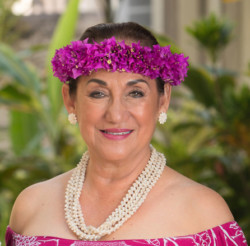National Arts Prize Winner Credits Molokai Roots
One of the most prestigious awards for the arts, the Dorothy and Lillian Gish Prize, was recently awarded to Vicky Holt Takamine of Oahu, for her work as a kumu hula and executive director of the PA’I Foundation. With the prize, which includes a cash amount of $450,000, Takamine joins the likes of Robert Redford, Bob Dylan, Spike Lee and more.
While she lives and works over on Oahu, Holt Takamine explained that it was time spent on Molokai as a girl during which she was first exposed to many of the Hawaiian cultural arts she champions today.
Holt Takamine’s family would spend their summers with the Place ‘ohana on Molokai’s east end. While her father worked, she would spend long summer days with “Grandma Place,” helping her with all sorts of crafts from sewing buttons on aloha shirts to making quilts to weaving lauhala. Camping in the yard with her cousins, Holt Takamine would help Grandma Place prepare for the Molokai state fair, with all different kinds of cooking and crafts.
“I remember being with all the cousins in her two-bedroom house and learning all about traditional cultural practices from my Molokai grandma,” Holt Takamine said. “It’s a dear, dear island for my family and me.”
And with these experiences came foundational ideas regarding the art of Hawaiian cultural practices. Along with her work as a hula teacher for over 30 years, Holt Takamine has worked to expand the definition of “fine art” to include Hawaiian cultural practices.
“Art is not just what we frame and put on the wall,” she said. “Art is the fisherman making fishhooks and fishing nets. Art is the farmer who takes care of the land. Art is the canoe paddler.”
Changing this perception of fine art to include Hawaiian cultural traditions is a way of challenging external narratives about practices like hula.
“[Hula] is always looked at as an artform for tourists’ entertainment and not a fine art,” said Holt Takamine. “For me, hula is a form of resistance.”
Along with activities like feather work, kapa and carving, hula was banned from 1830 to 1874. There were subsequent bans on teaching Hawaiian language in public schools lasting until the 1970s.
For Holt Takamine, the Gish Prize is an acknowledgement of how far support for Hawaiian practices has come, demonstrating, “the growth of our people and the recognition of hula on a national forum,” she explained.
Holt Takamine was nominated for the Gish Prize amongst 100 other arts leaders nationwide, receiving the award via unanimous decision.
“When we got to [Holt Takamine], her work just stood out in a new and different way,” explained Terrance McKnight, chairman of the Gish Prize’s selection committee. “[She’s] bringing people together under the idea of common humanity.”
“It was just a roller-coaster of emotions,” explained Holt Takamine when she got the call that she had been awarded the prize. “I was like, ‘are you kidding me?’”
The prize’s mission is to recognize an artist “who has enhanced the beauty of the world and worked to make society more whole, someone who is highly accomplished and yet remains an agent of change,” explained McKnight.
Art doesn’t just reflect who we are—it shapes the spaces we live in. From bold canvases to intricate sculpture, the pieces we choose to hang or display are often deeply personal and irreplaceable.
Whether it’s a centuries-old heirloom or a newly acquired piece that speaks to your soul, wall art deserves the same level of care and consideration as any other meaningful investment.
That’s especially true for those who curate collections that mix modern expression with timeless tradition, like christian wall decor, where spiritual messages and artistic design meet in striking harmony.
When you purchase art, you’re not just decorating a room—you’re preserving a story, an intention, a moment captured in brushstroke or form.
Protecting that investment isn’t just smart, it’s essential. From transportation to display, every step comes with potential risks that can be mitigated by thoughtful planning and the right support systems.
Because art isn’t only what we see—it’s what we choose to value.
It’s a big edict to fulfill, but ultimately “it’s not about me,” Holt Takamine explained. “It’s about my practice and my community.”












Don't have a Molokai Dispatch ID?
Sign up is easy. Sign up now
You must login to post a comment.
Lost Password